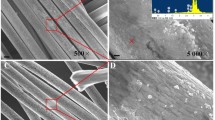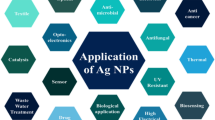Abstract
The use of nanosilver as an antibacterial agent for various products has increased, especially so, in textiles. This study aims to investigate the potential of Ag to leach from commercial products which contain nano-Ag by using the toxicity characteristic leaching procedure (TCLP) test in accordance with USEPA method 1311. Eight nano-Ag products were purchased from the market. Only those products that are likely to be disposed of in a landfill after end use were selected. Nano-Ag fabrics of different concentrations were also prepared at the laboratory scale, and the TCLP test was performed on them as well. The current study assumes that the new products were discarded without use. The Ag content was quantified by inductively coupled plasma–mass spectroscopy (ICP-MS) and ranged from 0.95 to 2.82 μg/g of the product in the commercial products and from 1.49 to 350 μg/g of the product in the lab-prepared fabrics. In the TCLP test results, Ag concentrations ranged from 4.3 to 64.9 μg/L in the commercial products and from 28.9 to 28,381 μg/L in the lab-prepared fabrics. The results also indicate that the amount of Ag released depends on the type of the fabrics. Additionally, the size of the nano-Ag released in percentage is different for each prepared fabric. This study can help in understanding the amount of Ag released during the disposal phase of a product in a landfill.





Similar content being viewed by others
References
Arvidsson, R., Molander, S., & Sanden, B. A. (2011). Impacts of a silver-coated future: particle flow analysis of silver nanoparticles. Journal of Industrial Ecology, 15(6), 844–854.
Aschberger, K., Micheletti, C., Sokull-Kluttgen, B., & Christensen, F. M. (2011). Analysis of currently available data for characterising the risk of engineered nanomaterials to the environment and human health - lessons learned from four case studies. Environment International, 37(6), 1143–1156.
Batchelor-McAuley, C., Tschulik, K., Neumann, C. C. M., Laborda, E., & Compton, R. G. (2014). Why are silver nanoparticles more toxic than bulk silver? Towards understanding the dissolution and toxicity of silver nanoparticles. International Journal of Electrochemical Science, 9(3), 1132–1138.
Benn, T. M., & Westerhoff, P. (2008). Nanoparticle silver released into water from commercially available sock fabrics. Environmental Science and Technology, 42(11), 4133–4139.
Benn, T. M., Cavanagh, B., Hristovski, K., Posner, J. D., & Westerhoff, P. (2010). The release of nanosilver from consumer products used in the home. Journal of Environmental Quality, 39(6), 1875–1882.
Boldrin, A., Hansen, S. F., Baun, A., Hartmann, N. I. B., & Astrup, T. F. (2014). Environmental exposure assessment framework for nanoparticles in solid waste. Journal of Nanoparticle Research, 16(6), 2394.
Choi, O., & Hu, Z. (2008). Size dependent and reactive oxygen species related nanosilver toxicity to nitrifying bacteria. Environmental Science and Technology, 42(12), 4583–4588.
DEPA (The Danish Environmental Protection Agency). (2012). Assessment of nanosilver in textiles on The Danish market. Environmental Project No.1432.
El-Rafie, M. H., Mohamed, A. A., Shaheen, T. H. I., & Hebeish, A. (2010). Antimicrobial effect of silver nanoparticles produced by fungal process on cotton fabrics. Carbohydrate Polymers, 80, 779–782.
Environmental Protection Agency (EPA). (1992). Standard method 1311 Toxicity Characteristic Leaching Procedure. SW-846 test methods for evaluating solid wastes, http://www.epa.gov/osw/hazard/testmethods/sw846/pdfs/1311.pdf. Accessed 20 June 2014.
Environmental Protection Agency (EPA). (1999). Identification and listing of hazardous wastes, Toxicity characteristics. Code of Federal Regulations, 40 CFR 261.24, Vol.18, No.261, 55–56.
Geranio, L., Heuberger, M., & Nowack, B. (2009). The behavior of silver nanotextiles during washing. Environmental Science and Technology, 43(21), 8113–8118.
KEMI. (2012). Antibacterial substances leaking out with the washing water—analyses of silver triclosan, and triclocarbon in textiles before and after washing. Sundbyberg: Swedish Chemicals Agency.
Kennedy, A. J., Hull, M. S., Bednar, A. J., Goss, J. D., Gunter, J. C., Bouldin, J. L., Vikesland, P. J., & Steevens, J. A. (2010). Fractionating nanosilver: importance for determining toxicity to aquatic test organisms. Environmental Science and Technology, 44(24), 9571–9577.
Kim, B., Park, C. S., Murayama, M., & Hochella, M. F. (2010). Discovery and characterization of silver sulfide nanoparticles in final sewage sludge products. Environmental Science and Technology, 44(19), 7509–7514.
Kulthong, K., Srisung, S., Boonpavanitchakul, K., Kangwansupamonkon, W., & Maniratnachote, R. (2010). Determination of silver nanoparticles release from antibacterial fabrics into artificial sweat. Particle and Fibre Toxicology, 1(7), 8.
Liang, Z., Das, A., & Hu, Z. (2010). Bacterial response to a shock load of nanosilver in an activated sludge treatment system. Water Research, 44(18), 5432–5438.
Liu, J., & Hurt, R. H. (2010). Ion release kinetics and particle persistence in aqueous nano-silver colloids. Environmental Science and Technology, 44(6), 2169–2175.
Lorenz, C., Windler, L., Goetz, N. V., Lehmann, R. P., Schuppler, M., Hungerbuhler, K., & Nowack, B. (2012). Characterization of silver release from commercial available functional (nano) textiles. Chemosphere, 89(7), 817–824.
McShan, D., Ray, P. C., & Yu, H. (2014). Molecular toxicity mechanism of nanosilver. Journal of Food and Drug Analysis, 22(1), 116–127.
Musee, N. (2010). Nanotechnology risk assessment from a waste management perspective: are the current tools adequate? Human and Experimental Toxicology, 30(8), 820–835.
Musson, S. E., Jang, Y. C., Townsend, T. G., & Chung, I. H. (2000). Characterization of lead leachability from cathode ray tubes using the toxicity characteristic leaching procedure. Environmental Science and Technology, 34(20), 4376–4381.
Parthasarathi, V., & Thilagavathi, G. (2009). Synthesis and characterization of titanium dioxide nano-particles and their application to textiles for microbe resistance. Journal of Textile and Apparel, Technology and Management, 6(2), 1–8.
Pasricha, A., Jangra, S. L., Singh, N., Dilbaghi, N., Sood, K. N., Arora, K., & Pasricha, R. (2012). Comparative study of leaching of silver nanoparticles from fabric and effective effluent treatment. Journal of Environment Sciences, 24(5), 852–859.
Patel, M. H., & Desai, P. B. (2015). Antimicrobial effect of herbal nanosilver finished fabrics on drug resistant pathogens. International Journal of Science and Research, 4(1), 427–432.
Peretyazhko, T. S., Zhang, Q., & Colvin, V. L. (2014). Size-controlled dissolution of silver nanoparticles at neutral and acidic pH conditions: kinetics and size changes. Environmental Science and Technology, 48(20), 11954–11961.
Project on Emerging Nanotechnologies. (2016). Online inventory of nanotechnology-based consumer products introduced on the market. http://www.nanotechproject.org/cpi. Accessed 20 Jan 2016.
Scheringer, M., MacLeod, M., Behra, T., Sigg, L., & Hungerbühler, K. (2010). Environmental risks associated with nanoparticulate silver used as biocide. Household and Personel Care Today, 6(2), 27–29.
Schluesener, J. K., & Schluesener, H. J. (2013). Nanosilver: application and novel aspects of toxicology. Archives of Toxicology, 87(4), 569–576.
Sporl, R., Wagenknecht, A., Simstich, B., Rumpel, J.W., Pauly, D., Hiermeier, P., Eichhorn, R.V. (2011). Report on impact of nanoscale silver. http://www.aquafit4use.eu/userdata/file/Public%20results/AquaFit4Use%20-20Impact%20of%20nanoscale%20silver.pdf. Accessed 20 June 2014.
Sun, T. Y., Gottschalk, F., Hungerbühler, K., & Nowack, B. (2014). Comprehensive probabilistic modelling of environmental emissions of engineered nanomaterials. Environmental Pollution, 185, 69–76.
Thanh, N. V. K., & Phong, N. T. P. (2009). Investigation of antibacterial activity of cotton fabric incorporating nano silver colloid. Journal of Physics: Conference Series, 187(1), 012072.
Throback, I. N., Johansson, M., Rosenquist, M., Pell, M., Hansson, M., & Hallin, S. (2007). Silver (Ag+) reduces denitrification and induces enrichment of novel nirK genotypes in soil. FEMS Microbiology Letters, 270(2), 189–194.
Ureyen, M. E., Gok, O., Ates, M., Gunkaya, G., & Suzer, S. (2010). Evaluation of silver content and antibacterial activities of silver loaded fiber/cotton blended textile fabrics. Journal of Textile and Apparel, 20(2), 137–144.
Whiteley, C. M., Valle, M. D., Jones, K. C., & Sweetman, A. J. (2011). Challenges in assessing the environmental fate and exposure of nano silver. Journal of Physics: Conference Series, 304, 012070.
Wijnhoven, S. W. P., Peijnenburg, W. J. G. M., Herberts, C. A., Hagens, W. I., Oomen, A. G., Heugens, E. H. W., Roszek, B., Bisschops, J., Gosens, I., Meent, D. V. D., Dekkers, S., Jong, W. H. D., Zijverden, M. V., Sips, A. J. A. M., & Geertsma, R. E. (2009). Nano-silver - a review of available data and knowledge gaps in Human and environmental risk assessment. Nanotoxicology, 3(2), 109–138.
Windler, L., Height, M., & Nowack, B. (2013). Comparative evaluation of antimicrobials for textile applications. Environment International, 53, 62–73.
Yang, Y., Xu, M., Wall, J. D., & Hu, Z. Q. (2012). Nanosilver impact on methanogenesis and biogas production frommunicipal solid waste. Waste Management, 32(5), 816–825.
Yang, Y., Gajaraj, S., Wall, J. D., & Hu, Z. (2013). A comparison of nanosilver and silver ion effects on bioreactor landfill operations and methanogenic population dynamic. Water Research, 47(10), 3422–3440.
Acknowledgments
This research was financially supported by The Royal Golden Jubilee PhD Program (RGJ) under the organization of the Thailand Research Fund (TRF), Grant No. PHD/0307/2552. We thank the RGJ for providing funds for the study.
Author information
Authors and Affiliations
Corresponding author
Rights and permissions
About this article
Cite this article
Limpiteeprakan, P., Babel, S. Leaching potential of silver from nanosilver-treated textile products. Environ Monit Assess 188, 156 (2016). https://doi.org/10.1007/s10661-016-5158-x
Received:
Accepted:
Published:
DOI: https://doi.org/10.1007/s10661-016-5158-x




